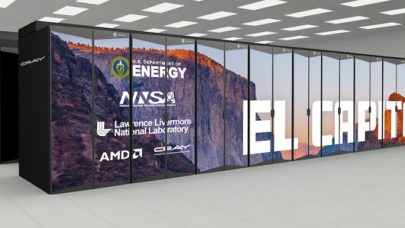
What’s Stirring in Nvidia’s R&D Lab? Chief Scientist Bill Dally Provides a Peek
March 28, 2023
In what’s become a regular GPU Technology Conference feature, Bill Dally, Nvidia chief scientist and SVP of research, provides a glimpse into how Nvidia organ Read more…

Nvidia R&D Chief on How AI is Improving Chip Design
April 18, 2022
Getting a glimpse into Nvidia’s R&D has become a regular feature of the spring GTC conference with Bill Dally, chief scientist and senior vice president of research, providing an overview of Nvidia’s R&D organization and a few details on current priorities. This year, Dally focused mostly on AI tools that Nvidia is both developing and using in-house to improve... Read more…

Nvidia Debuts BlueField-3 – Its Next DPU with Big Plans for an Expanded Role
April 12, 2021
Nvidia today announced its next generation data processing unit (DPU) – BlueField-3 – adding more substance to its evolving concept of the DPU as a full-fledged partner to CPUs and GPUs in delivering advanced computing. Nvidia is pitching the DPU as an active engine... Read more…

Nvidia Rolls Out Certified Server Program Targeting AI Applications
January 26, 2021
Nvidia today launched a certified systems program in which participating vendors can offer Nvidia-certified servers with up to eight A100 GPUs. Separate support Read more…

Exascale Watch: El Capitan Will Use AMD CPUs & GPUs to Reach 2 Exaflops
March 4, 2020
HPE and its collaborators reported today that El Capitan, the forthcoming exascale supercomputer to be sited at Lawrence Livermore National Laboratory and serve Read more…

AI-based Cancer Protein Simulation is Finalist for SC19 Best Paper
November 4, 2019
Accurate simulation of cancer-implicated proteins holds enormous promise for basic biomedical science and development of effective therapies, but the high compu Read more…

Nvidia Debuts Clara AI Toolkit with Pre-Trained Models for Radiology Use
March 19, 2019
AI’s push into healthcare got a boost yesterday with Nvidia’s release of the Clara Deploy AI toolkit which includes 13 pre-trained models for use in radiolo Read more…

Neural Networking Shows Promise in Earthquake Monitoring
February 21, 2018
A team of Harvard University and MIT researchers report their new neural networking method for monitoring earthquakes is more accurate and orders of magnitude faster than traditional approaches. Read more…

- Click Here for More Headlines

Whitepaper
How Direct Liquid Cooling Improves Data Center Energy Efficiency
Data centers are experiencing increasing power consumption, space constraints and cooling demands due to the unprecedented computing power required by today’s chips and servers. HVAC cooling systems consume approximately 40% of a data center’s electricity. These systems traditionally use air conditioning, air handling and fans to cool the data center facility and IT equipment, ultimately resulting in high energy consumption and high carbon emissions. Data centers are moving to direct liquid cooled (DLC) systems to improve cooling efficiency thus lowering their PUE, operating expenses (OPEX) and carbon footprint.
This paper describes how CoolIT Systems (CoolIT) meets the need for improved energy efficiency in data centers and includes case studies that show how CoolIT’s DLC solutions improve energy efficiency, increase rack density, lower OPEX, and enable sustainability programs. CoolIT is the global market and innovation leader in scalable DLC solutions for the world’s most demanding computing environments. CoolIT’s end-to-end solutions meet the rising demand in cooling and the rising demand for energy efficiency.
Download Now
Sponsored by CoolIT
Whitepaper
Transforming Industrial and Automotive Manufacturing
Divergent Technologies developed a digital production system that can revolutionize automotive and industrial scale manufacturing. Divergent uses new manufacturing solutions and their Divergent Adaptive Production System (DAPS™) software to make vehicle manufacturing more efficient, less costly and decrease manufacturing waste by replacing existing design and production processes.
Divergent initially used on-premises workstations to run HPC simulations but faced challenges because their workstations could not achieve fast enough simulation times. Divergent also needed to free staff from managing the HPC system, CAE integration and IT update tasks.
Download Now
Sponsored by TotalCAE
Advanced Scale Career Development & Workforce Enhancement Center
Featured Advanced Scale Jobs:
HPCwire Resource Library
HPCwire Product Showcase
© 2024 HPCwire. All Rights Reserved. A Tabor Communications Publication
HPCwire is a registered trademark of Tabor Communications, Inc. Use of this site is governed by our Terms of Use and Privacy Policy.
Reproduction in whole or in part in any form or medium without express written permission of Tabor Communications, Inc. is prohibited.
























